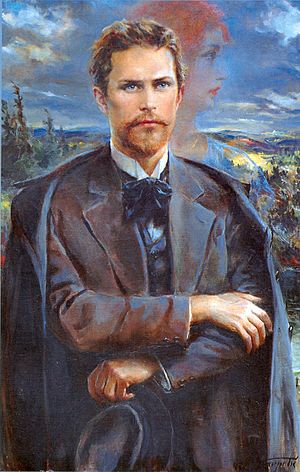Dragotin Kette facts for kids
Quick facts for kids
Dragotin Kette
|
|
|---|---|

Kette by Ivan Vavpotič (1932)
|
|
| Born | January 19, 1876 Prem near Ilirska Bistrica, Duchy of Carniola, Austria-Hungary (now in Slovenia) |
| Died | April 26, 1899 (aged 23) Ljubljana, Duchy of Carniola, Austria-Hungary (now in Slovenia) |
| Occupation | Poet |
| Literary movement | Fin de siecle, Neo-romanticism |
Dragotin Kette (born January 19, 1876 – died April 26, 1899) was an important Slovene poet. He wrote poems that were like Impressionist paintings or Neo-Romantic stories. He is seen as one of the people who started modernism in Slovene literature. He did this along with his friends Josip Murn, Ivan Cankar, and Oton Župančič.
Life of Dragotin Kette
Dragotin Kette was born in a small village called Prem. This village was near the town of Ilirska Bistrica in a region called Carniola. At that time, it was part of the Austro-Hungarian Empire. Today, this area is in Slovenia.
His father was a teacher and also led a choir. Kette's mother passed away when he was only four years old.
In 1898, he started attending the State Secondary School in Ljubljana. However, in 1894, his uncle, Janez Valenčič, stopped paying for his school. This happened because Kette wrote some funny poems about the bishop of Ljubljana, Jakob Missia. These poems were published in a student newspaper.
Because of this, Kette had to move and continue his studies in Novo Mesto. He finished high school there in 1898. While in Novo Mesto, he fell in love with Angela Smola. She was the daughter of the local judge. Kette wrote many of his poems for her.
During his high school years, he met other young writers. These included Ivan Cankar, Oton Župančič, and Josip Murn. They were all bringing new, modern ideas into Slovene literature.
After finishing high school, Kette joined the Austro-Hungarian Army. He was sent to a city called Trieste. Sadly, in Trieste, he became very sick with tuberculosis. He then returned to Ljubljana. He lived in a small room in a simple building near the Ljubljanica River. He died there in 1899 when he was just 23 years old. In his last weeks, his good friend Josip Murn took care of him. Josip Murn himself died two years later in the very same room.
Dragotin Kette is buried in the Žale cemetery. This cemetery is in the Bežigrad area of Ljubljana.
Dragotin Kette's Works
Kette's poems were mainly inspired by Slovene folk songs. He also looked up to famous writers like Goethe, Heine, and Prešeren.
Through his friends, he learned about French symbolist and decadent poets. These included Paul Verlaine and Maurice Maeterlinck. But Kette decided not to follow their style. Instead, he found his own unique way of writing. His style was similar to the new romantic trends popular in Europe around the turn of the century.
Some of his most famous poems are "Na trgu" (meaning "On the Square"). This is a lyrical and impressionist poem. Another well-known work is a group of eight poems called "Na Molu San Carlo" (meaning "On Saint Charles Pier"). He wrote these poems while he was in Trieste.
Kette is also well-known for writing popular children's literature. He wrote about 25 stories and poems for children. Some of his best-known children's works are "The Tale of the Dressmaker and the Little Scissors," "The Sultan and the Doggy," and "The Bee and the Bumblebee." His children's stories are still loved today. They have been translated into many languages. These include German, Czech, Serbian, Croatian, Macedonian, and Hungarian.
Influence and Legacy
Unlike his friend Josip Murn, Dragotin Kette became a recognized poet during his lifetime. When he died, there was a feeling of sadness across the country. Many important people, including the mayor of Ljubljana, Ivan Hribar, went to his funeral.
His collected poems were published in 1900. The book was put together by Anton Aškerc. At that time, Aškerc was considered the most important Slovene writer. However, Aškerc had actually rejected Kette's poems before. The introduction Aškerc wrote for the book was seen as rude and looking down on Kette. This made Ivan Cankar and Oton Župančič very upset. It led to a public argument. In this argument, the younger Slovene writers challenged the old ways of thinking about art. These older ideas were represented by Aškerc.
On the first anniversary of Kette's death, Ivan Cankar wrote an important essay about him. It started with these words:
A year ago, Dragotin Kette passed away in Ljubljana and some newspapers reported that we had lost a very talented poet. Few realized that the young man that had died was the biggest talent we have had since Prešeren.
Kette had a big impact on many future Slovene writers. Some of these writers include Alojz Gradnik, Srečko Kosovel, Miran Jarc, Ivan Minatti, Janez Menart, Kajetan Kovič, and Ciril Zlobec.
Images for kids



